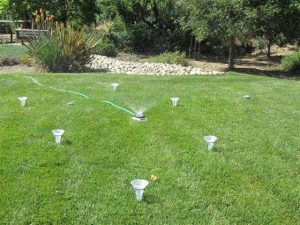Most of us could use a little help in determining how much to water our gardens during a drought both to conserve water and, if possible, save the trees, shrubs and other plants we cherish. Here are a few guidelines and tools to help you determine watering needs with the drought in mind:
Remember the 50 Percent Rule Many established landscape plants can survive on about half of their ideal water needs for at least one season of severe drought. But first you need to know how deeply a particular plant likes to be watered. The University of California Master Gardener Handbook offers this general guideline for determining how deeply three different classifications of plants should be watered under non-drought conditions:
- Leafy vegetables and annual bedding plants: 6 inches to 1 foot
- Small shrubs, cool-season turf grass, corn and tomatoes: 1 to 2 feet
- Large shrubs, trees, warm-season turf grass: 1.5 to 5 feet
Using a rough guide like this, you can approximate what watering depth represents 50 percent of ideal. (The caveat is, depending on the plants or landscapes in question, plus state and local water restrictions, you may have to settle for even less than half of an ideal watering depth.)
Know How Deep Once you determine how deep to water, how do you know if your irrigation system is reaching that depth? You can buy portable soil meters. Or you can drive a long screwdriver into the soil, then pull it out and check to see how much of the tool holds moist soil. If you like to get your hands dirty and you’d also like to learn more about your soil composition go for the feel test. With a trowel or shovel, dig to roughly half the plants ideal moisture depth. Place a handful of soil from the bottom of the hole into your palm, then close your hand and squeeze. You are at roughly the 50 percent depth if the characteristics of the soil in your hand match one of the following:
- Sandy Loam: Still appears dry, will not form a ball with pressure
- Clay Loam: A little crumbly but will hold together under pressure
- Clay: Will form a ball under pressure
If rivulets of water run from the soil when squeezed, or if the soil easily ribbons out between your fingers and feels slick, you are overwatering. You should only need to test for soil-moisture depth once or twice during the growing season if your watering schedule is consistent.
With the right tools and practices (and the right plants), we have a better chance of saving the gardens we love.
Rachel Oppedahl is a UCCE Master Gardener of Tuolumne County who is mathematically challenged, so she will be watching for wilting leaves and digging holes to manage landscape watering.


